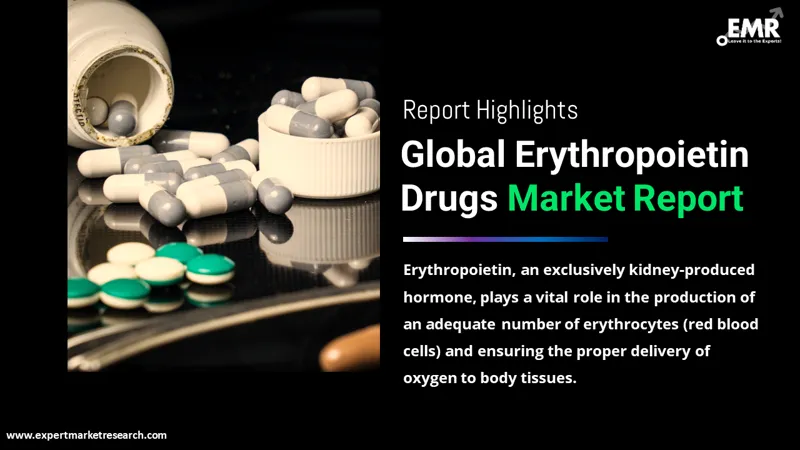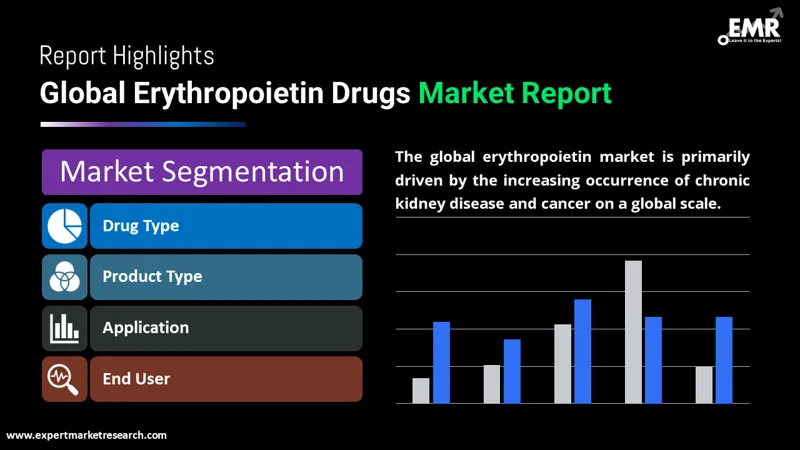
Consumer Insights
Uncover trends and behaviors shaping consumer choices today
Procurement Insights
Optimize your sourcing strategy with key market data
Industry Stats
Stay ahead with the latest trends and market analysis.
The global erythropoietin drugs market was valued at USD 11.51 Billion in 2025, driven by the increasing prevalence of chronic kidney diseases and diabetes, cancer across the globe. The market size is anticipated to grow at a CAGR of 5.70% during the forecast period of 2026-2035 to achieve a value of USD 20.04 Billion by 2035.
Base Year
Historical Period
Forecast Period
Compound Annual Growth Rate
5.7%
Value in USD Billion
2026-2035
*this image is indicative*
Erythropoietin is a hormone solely produced by the kidneys in a human body. This hormone helps in generating enough erythrocytes (red blood cells) in body by delivering proper amount of oxygen among body tissues. When this oxygen turns into energy, carbon dioxide releases. Red blood cells are also responsible for delivering carbon dioxide to the lung to exhale it out of the body. Usually, when low oxygen levels are encountered, the specialized cells located in the kidneys boosts the production of Erythropoietin.

Read more about this report - REQUEST FREE SAMPLE COPY IN PDF
These drugs are widely used for the treatment of anemia, kidney diseases, cancer, and patients undergoing chemotherapies or dialysis. These drugs can be consumed in the form of injections or subcutaneous implants. Stimulation of bone marrow helps erythropoietin drugs to produce more red blood cells, resulting in improved capacity of carrying oxygen, and relieve the symptoms related with anemia.
There are several key trends running in the market and some of them include the rising prevalence of chronic kidney diseases. The rise in ageing population is causing increased prevalence of diabetes and hypertension, leading to higher demand for erythropoietin drugs. Along with it, the increasing use of these drugs in oncology, advancements in drug delivery systems, expiration of biosimilars and patents are also among the key trends aiding the market growth.

Read more about this report - REQUEST FREE SAMPLE COPY IN PDF
The EMR’s report titled “Erythropoietin Drugs Market Report and Forecast 2026-2035” offers a detailed analysis of the market based on the following segments:
Market Breakup by Drug Type
Market Breakup by Product Type
Market Breakup by Application
Market Breakup by End User
Market Breakup by Region
The global market size for erythropoietin drugs has been constantly growing and is expected to witness gradual growth in future as well. The increasing prevalence of anaemia and increasing demand for biosimilar and biological drugs are directly contributing to the growth of market size. The major cause of anaemia such as unhealthy diets and increasing chronic diseases, along with intestinal issues, and some other infections are increasing the demand for biosimilar drugs, and directly contributing to the growth of the erythropoietin drugs market size.
Due to the increasing rate of development of anaemia in more people the demand for erythropoietin drugs has also increased as they are approved by healthcare professionals easily and the research authorities. These fast approvals result in increased availability and increased production of the drug to directly support the growth of the erythropoietin drug market size.
The key features of the market report include patent analysis, grants analysis, clinical trials analysis, funding and investment analysis, partnerships, and collaborations analysis by the leading key players. The major companies in the market are as follows:




*While we strive to always give you current and accurate information, the numbers depicted on the website are indicative and may differ from the actual numbers in the main report. At Expert Market Research, we aim to bring you the latest insights and trends in the market. Using our analyses and forecasts, stakeholders can understand the market dynamics, navigate challenges, and capitalize on opportunities to make data-driven strategic decisions.*
Get in touch with us for a customized solution tailored to your unique requirements and save upto 35%!
The global market was valued at USD 11.51 Billion in 2025.
The global erythropoietin market size is anticipated to grow at a CAGR of 5.70% during the forecast period of 2026-2035 and reach a market value of USD 20.04 Billion by 2035.
The rising incidence and prevalence of chronic kidney disease and cancer worldwide are the major drivers for the global erythropoietin market.
The different types of drugs in the market are biologics and biosimilars.
The different type of products in the market includes epoetin-alfa, epoetin-beta, and darbepoetin-alfa, among others.
The end users of the erythropoietin drugs include hospitals, homecare, and speciality clinics, among others.
The different applications of erythropoietin drugs include haematology, kidney disorder, cancer, among others.
The major regions of the market include North America, Europe, Asia Pacific, Latin America, Middle East and Africa.
The key players involved in the market are Amgen Inc., Biocon Limited, Dr. Reddy’s Laboratories Ltd., F. Hoffmann-La Roche AG, Intas Pharmaceuticals Ltd., Johnson & Johnson, LG Chem Ltd., Pfizer Inc., Teva Pharmaceutical Industries Ltd., and Sun Pharmaceutical Industries Limited.
Explore our key highlights of the report and gain a concise overview of key findings, trends, and actionable insights that will empower your strategic decisions.
| REPORT FEATURES | DETAILS |
| Base Year | 2025 |
| Historical Period | 2019-2025 |
| Forecast Period | 2026-2035 |
| Scope of the Report |
Historical and Forecast Trends, Industry Drivers and Constraints, Historical and Forecast Market Analysis by Segment:
|
| Breakup by Drug Type |
|
| Breakup by Product Type |
|
| Breakup by Application |
|
| Breakup by End User |
|
| Breakup by Region |
|
| Market Dynamics |
|
| Competitive Landscape |
|
| Companies Covered |
|
Datasheet
One User
USD 3,299
USD 2,969
tax inclusive*
Single User License
One User
USD 5,499
USD 4,949
tax inclusive*
Five User License
Five User
USD 6,999
USD 5,949
tax inclusive*
Corporate License
Unlimited Users
USD 8,199
USD 6,969
tax inclusive*
*Please note that the prices mentioned below are starting prices for each bundle type. Kindly contact our team for further details.*
Flash Bundle
Small Business Bundle
Growth Bundle
Enterprise Bundle
*Please note that the prices mentioned below are starting prices for each bundle type. Kindly contact our team for further details.*
Flash Bundle
Number of Reports: 3
20%
tax inclusive*
Small Business Bundle
Number of Reports: 5
25%
tax inclusive*
Growth Bundle
Number of Reports: 8
30%
tax inclusive*
Enterprise Bundle
Number of Reports: 10
35%
tax inclusive*
How To Order

Select License Type
Choose the right license for your needs and access rights.

Click on ‘Buy Now’
Add the report to your cart with one click and proceed to register.

Select Mode of Payment
Choose a payment option for a secure checkout. You will be redirected accordingly.
Gain insights to stay ahead and seize opportunities.

Get insights & trends for a competitive edge.

Track prices with detailed trend reports.

Analyse trade data for supply chain insights.

Leverage cost reports for smart savings

Enhance supply chain with partnerships.

Connect For More Information
Our expert team of analysts will offer full support and resolve any queries regarding the report, before and after the purchase.
Our expert team of analysts will offer full support and resolve any queries regarding the report, before and after the purchase.
We employ meticulous research methods, blending advanced analytics and expert insights to deliver accurate, actionable industry intelligence, staying ahead of competitors.
Our skilled analysts offer unparalleled competitive advantage with detailed insights on current and emerging markets, ensuring your strategic edge.
We offer an in-depth yet simplified presentation of industry insights and analysis to meet your specific requirements effectively.
Share